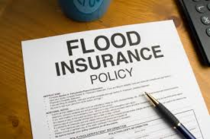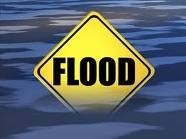NFIP Notice & Verification of Primary Residence Form
NFIP Verification of Primary Residence F[...]
Adobe Acrobat document [102.0 KB]
FLOOD INSURANCE INFORMATION
What is a Flood?
Here's how "flood" is defined by the National Flood Insurance Program: "A general and temporary condition of partial or complete inundation of two or more acres of normally dry land area or of two or
more properties (at least one of which is the policyholder's property) from:
- Overflow of inland or tidal waters; or
- Unusual and rapid accumulation or runoff of surface waters from any source; or
- Mudflow; or
Collapse or subsidence of land along the shore of a lake or similar body of water as a result of erosion or undermining caused by waves or currents of water
What are my flood options?
So, in plain English, a flood is an excess of water (or mud) on land that's normally dry. Floods often happen when bodies of water overflow or tides rise due to heavy rainfall or thawing snow. But
you don't have to live near water to be at risk of flooding. A flash flood, which can strike anywhere without warning, occurs when a large volume of rain falls within a short time.
More and more buildings, roads and parking lots are being built where forests and meadows used to be, which decreases the land's natural ability to absorb water. Coupled with changing weather patterns, this construction has made recent floods more severe and increased everyone's chance of being flooded.
Dangerous or damaging floods don't always mean dramatic, rushing waters through the streets of your hometown. Just a single inch of water can cause costly damage to your home! Keep this in mind when you're considering flood insurance.
There's something you should know: Flood losses aren't covered by your homeowners insurance policy.
Floodwaters have the power to damage not only your home and sense of security, but also your financial future. How can you protect your most important investment in case of flooding?
Option 1: Hope that you'll receive Federal disaster relief if a flood hits.
Many people wrongly believe that theU.S.government will take care of all their financial needs if they suffer damage due to flooding. The truth is that Federal disaster assistance is only available if the President formally declares a disaster. Even if you do get disaster assistance, it's often a loan you have to repay, with interest, in addition to your mortgage loan that you still owe on the damaged property.
Most importantly, you must consider the fact that if your home is flooded and disaster assistance isn't offered, you'll have to shoulder the massive damage costs alone.
The bottom line? If you're looking for secure protection from financial loss due to flood damage, Federal disaster assistance is not the answer.
Option 2: Buy flood insurance and stay protected no matter what.
When disaster strikes, flood insurance policyholder claims are paid even if a disaster is not Federally declared.
Flood insurance means you'll be reimbursed for all your covered losses. And unlike Federal aid, it never has to be repaid.
As long as your community participates in the National Flood Insurance Program (NFIP), you're eligible to purchase flood insurance. To find out if your community participates, contact your local Selective agent. As a homeowner, you can insure your home up to $250,000 and its contents up to $100,000. If you're a renter, you can cover your belongings up to $100,000. As a non-residential property owner, you can insure your building and its contents up to $500,000.
In general, a policy does not take effect until 30 days after you purchase flood insurance. So, if the weather forecast announces a flood alert for your area and you go to purchase coverage, it's already too late. You will not be insured if you buy a policy a few days before a flood.
A flood insurance policy is easy to get, affordable and offers invaluable peace of mind. With flood insurance, you know you're covered... no matter what.
Be FloodSmart! Get covered today. Contact Home and Farm today!
Before the Flood
Besides insuring your property, there are other things you can do before a flood to minimize potential loss to your home and ensure your family's safety.
- Take photos or videos of all of your important possessions. If your home is damaged in a flood, these documents will help you file a full flood insurance claim.
- Store important documents and irreplaceable personal objects (such as photographs) where they won't get damaged. If major flooding is expected, consider putting them in a storage facility.
- Post emergency telephone numbers by the phone. Teach children to dial 911.
- Plan and practice a flood evacuation route with your family.
- Ask an out-of-state relative or friend to be the "family contact" in case your family is separated during a flood. Make sure everyone in your family knows the name, address, and phone number of this contact person.
- Buy and install sump pumps with back-up power.
- Have a licensed electrician raise electric components (switches, sockets, circuit breakers and wiring) at least 12" above your home's projected flood elevation.
- For drains, toilets, and other sewer connections, install backflow valves or plugs to prevent floodwaters from entering.
- Anchor fuel tanks. An unanchored tank in your basement can be torn free by flood waters, and the broken supply line can contaminate your basement. An unanchored tank outside can be swept downstream, where it can damage other houses.
- If your washer and dryer are in the basement, elevate them on masonry or pressure-treated lumber at least 12" above the projected flood elevation.
- Place the furnace and water heater on masonry blocks or concrete at least 12" above the projected flood elevation.
During the Flood
You've done everything in your power to prepare for a flood. You've secured a flood insurance policy, and made your home flood-ready. Congratulations! You've become "flood smart."
Now, the floodwaters are rising, and there's nothing you can do to stop them. But there are things you can do to make sure your family stays safe until the water levels drop again.
- Fill bathtubs, sinks, and jugs with clean water in case water becomes contaminated.
- Listen to a battery-operated radio for the latest storm information.
- If local authorities instruct you to do so, turn off all utilities at the main power switch and close the main gas valve.
- If told to evacuate your home, do so immediately.
- If the waters start to rise inside your house before you have evacuated, retreat to the second floor, the attic, and if necessary, the roof.
- Floodwaters may carry raw sewage, chemical waste and other disease-spreading substances. If you've come in contact with floodwaters, wash your hands with soap and disinfected water.
- Avoid walking through floodwaters. As little as six inches of moving water can knock you off your feet.
- Don't drive through a flooded area. If you come upon a flooded road, turn around and go another way. A car can be carried away by just 2 feet of flood water.
- Electric current passes easily through water, so stay away from downed power lines and electrical wires.
- Look out for animals - especially snakes. Animals lose their homes in floods, too.
After the Flood
Your community has been flooded, and your property has suffered flood damage. Stay calm and stay safe in the days ahead by following these instructions.
- If your home has suffered damage, call the agent who handles your flood insurance to file a claim. If you are unable to stay in your home, make sure to say where you can be reached.
- Take photos of any water in the house and save damaged personal property. This will make filing your claim easier. If necessary, place these items outside the home. An insurance adjuster will need to see what's been damaged in order to process your claim.
- Check for structural damage before re-entering your home. Don't go in if there is a chance of the building collapsing.
- Do not use matches, cigarette lighters or other open flames upon re-entering your property. Gas may be trapped inside. If you smell gas or hear hissing, open a window, leave quickly, and call the gas company from a neighbor's home.
- Keep power off until an electrician has inspected your system for safety.
- Avoid using the toilets and the tap until you have checked for sewage and water line damage. If you suspect damage, call a plumber.
- Throw away any food - including canned goods - that has come in contact with floodwaters.
- Boil water for drinking and food preparation until local authorities declare your water supply to be safe.
- Salvage water-damaged books, heirlooms and photographs using restoration tips from the NFIP.
Follow local building codes and ordinances when rebuilding. Use flood-resistant materials and techniques to protect your property from future flood damage.











